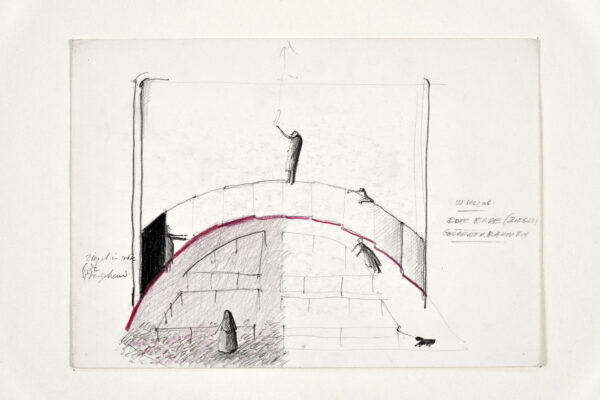Estate of the set designer and opera director Karl-Ernst Herrmann (1936-2018)
The graphic collection of the German Theatre Museum receives a significant addition with the estate of the stage and costume designer Karl-Ernst Herrmann (1936-2018). Minister of Culture Markus Blume emphasises: “Karl-Ernst Herrmann was already a legend in his field during his lifetime. With the acquisition of his estate, the legacy of a stage designer who has significantly influenced the German theatre landscape comes to Munich. I am very pleased that with Herrmann’s visionary designs, the important graphic collection of the German Theatre Museum grows by yet another jewel.”
The estate comprises approximately 1,600 graphic sheets, mainly stage designs, schematic drawings, and costume designs, covering over 60 theatre productions by influential directors of European spoken and musical theatre, including Peter Stein, Claus Peymann, and Luc Bondy. The scenographic works in his estate date from 1972 to 2018, encompassing Karl-Ernst Herrmann’s entire creative period. “The meticulously drawn sheets exemplarily document fundamental developments in theatre aesthetics at the threshold to the 21st century,” says museum director Dr. Dorothea Volz, expressing her delight at the acquisition.
Karl-Ernst Herrmann was born in 1936 in Neukirch in the Lusatia region. In the 1950s, he began training as a stage designer in Berlin. He initially assisted the aesthetically influential stage designer Wilfried Minks in Ulm in the early 1960s. Influenced by the 68 movement and its impact on cultural institutions, Karl-Ernst Herrmann became an active designer of a theatre focused on the major themes of the time. He co-founded the Schaubühne in Berlin, whose stage aesthetics bore his signature for a long time. Closely connected to the artistic director Claus Peymann, he followed him to further important stages in the German-speaking world. However, well beyond this collaboration, his stage designs after 1980 were present in Salzburg and Vienna as well as in Bochum, Stuttgart, and at the Berliner Ensemble in all three disciplines (opera, drama, and ballet).
While Karl-Ernst Herrmann worked equally in spoken and musical theatre in the early years, the focus of his later work increasingly shifted to opera. Here, he began his career as a director. Together with his wife, Ursel Herrmann, he directed at the largest European opera houses and often took on the set design as well.
A close connection to Munich has existed since 1994: until 2002, he held the chair for stage design at the Academy of Fine Arts in the Bavarian capital, alongside his wife, Ursel Herrmann. He joins the ranks of stage designers teaching in Munich, such as Emil Preetorius and Ekkehard Grübler, whose estates are also housed in the German Theatre Museum. Dr. Susanne de Ponte, head of the graphic collection, sees a remarkable uniqueness in Karl-Ernst Herrmann's distinctive drawing style. “His sketches are meticulously executed and reveal individual, often minute realistic details, featuring partially iconic elements such as the hyper-realistic manhole cover from the 1987 production of Richard III at the Burgtheater in Vienna.” According to de Ponte, the drawings are almost unpretentious, functioning as schematic and functional drawings, thus exemplifying the creative process of set design. In their reduction, they represent a departure from representative opulence and programmatically serve the production.
The foundation established by the stage designer through his will, “Bei Herrmann zwischen den Deichen,” which has entrusted the estate to the German Theatre Museum, supports emerging artists through a residency programme. “We also desire an artistic engagement with the work of Karl-Ernst Herrmann. The German Theatre Museum will assist the scholarship recipients by making the estate accessible. This includes the presentation of the estate in the special exhibitions of the German Theatre Museum,” emphasises foundation chair Martina Brinkhaus. In the current special exhibition “Ruth Walz. Doppelbelichtung” (12 October 2023 - 4 February 2024), production photographs of Richard III along with original designs can already be seen.
The acquisition of the estate of Karl-Ernst Herrmann represents a significant enhancement of the holdings of the graphic collection of the German Theatre Museum regarding stage design in the 20th century. The DTM already houses the estates and legacies of important stage designers such as Caspar Neher, Helmut Jürgens, Jürgen Rose, and Karl Kneidl.











